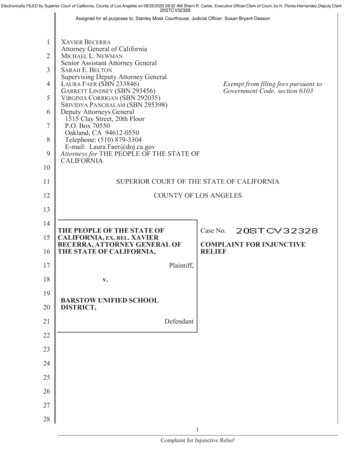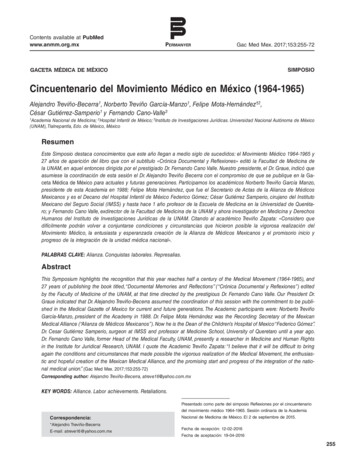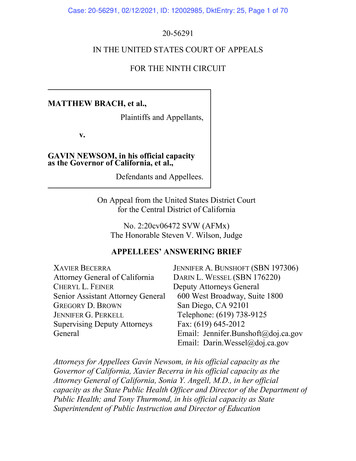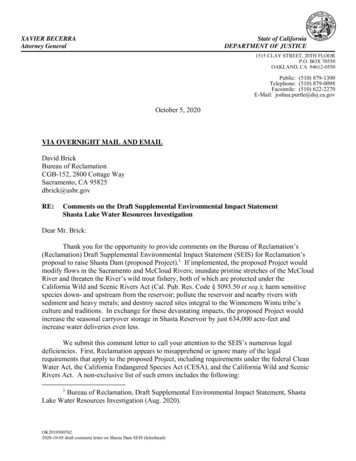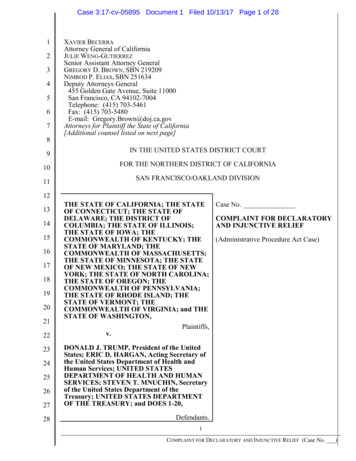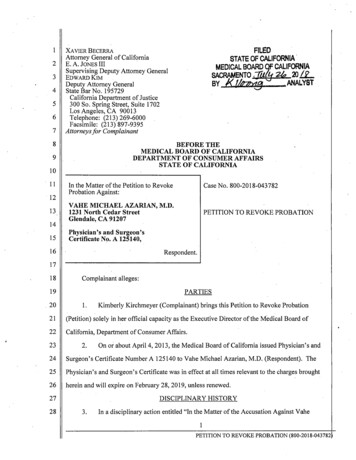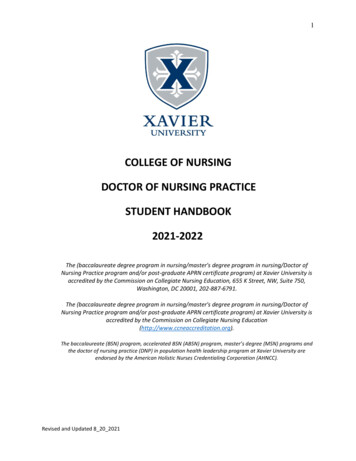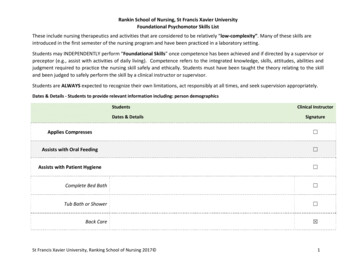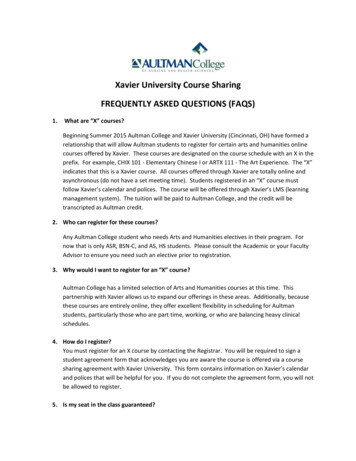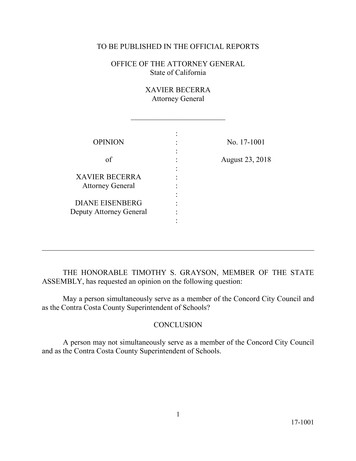
Transcription
TO BE PUBLISHED IN THE OFFICIAL REPORTSOFFICE OF THE ATTORNEY GENERALState of CaliforniaXAVIER BECERRAAttorney GeneralOPINIONofXAVIER BECERRAAttorney GeneralDIANE EISENBERGDeputy Attorney General:::::::::::No. 17-1001August 23, 2018THE HONORABLE TIMOTHY S. GRAYSON, MEMBER OF THE STATEASSEMBLY, has requested an opinion on the following question:May a person simultaneously serve as a member of the Concord City Council andas the Contra Costa County Superintendent of Schools?CONCLUSIONA person may not simultaneously serve as a member of the Concord City Counciland as the Contra Costa County Superintendent of Schools.117-1001
ANALYSISThe City of Concord (“Concord”) is wholly located within Contra Costa County.Concord is a general law city that is governed by a city council comprising five electedmembers, each of whom serves a four-year term.1 The city council has appointed a citymanager who is responsible for management functions of the city.2 Concord lies entirelywithin the boundaries of the Mt. Diablo Unified School District (“Mt. Diablo SchoolDistrict”), which also includes certain other cities, as well as unincorporated areas, inContra Costa County.3The California Constitution calls for the election or appointment of a superintendentof schools and a board of education for each county.4 The Contra Costa CountySuperintendent of Schools is elected, as is the county’s five-member Board of Education.5Together, the superintendent and board lead the Contra Costa County Office of Education.6In addition to the Mt. Diablo School District, there are 17 other kindergarten-through-12thgrade public school districts in Contra Costa County under the jurisdiction of the countyoffice of education.7City of Concord, “City Government Overview,” http://www.cityofconcord.org/page.asp?pid 5001 (as of Apr. 23, 2018). Each year, the council selects one of itsmembers to serve as mayor and another as vice-mayor. (Ibid.)1Ibid.; see also Gov. Code, § 34851 (city manager form of government may beestablished by ordinance); Concord Mun. Code, § 2.10.120, subd. (a) (providing forappointment of city manager).2City of Concord, “Education and Literacy,” http://www.cityofconcord.org/page.asp?pid 6020 (as of Apr. 23, 2018); MapTechnica, “Mt. Diablo USD BoundaryMap,” /Mount Diablo Unified School District/unsd/0626370 (as of Apr. 23, 2018).34Cal. Const., art. IX, §§ 3, 7; see also Ed. Code, § 1000.Contra Costa County Office of Education, “Contra Costa County Office of EducationFacts at a Glance,” er ics/GeneralAgencyFactSheet.pdf (as of Aug. 23, 2018).5Ibid. “The county superintendent is the head of the county office [of education]; thecounty board of education is its governing board.” (Today’s Fresh Start, Inc. v. L.A.County Off. of Ed. (2013) 57 Cal.4th 197, 207, fn. 4.)6Contra Costa County Office of Education, “County School Districts,” https://www.cccoe.k12.ca.us/district resources/county school districts (as of Apr. 23,2018).7217-1001
We are asked to determine whether a member of the Concord City Council maysimultaneously serve as the Contra Costa County Superintendent of Schools. We conductthis inquiry with reference to the doctrine of incompatible offices, which prohibits a personfrom concurrently holding two public offices if the performance of the duties of eitheroffice could have a significant adverse effect on the other.8 “The doctrine springs fromconsiderations of public policy which demand that a public officer discharge his or herduties with undivided loyalty.”9We find that simultaneously holding the positions of city council member andcounty superintendent of schools of the county in which the city is located would indeedrun afoul of the incompatible offices prohibition. Accordingly, we conclude that a memberof the Concord City Council may not also serve, at the same time, as the Contra CostaCounty Superintendent of Schools. We explain our reasoning and conclusion in greaterdetail below.Government Code Section 1099For many years, the doctrine of incompatible offices was developed and expressedonly in common law. In 2005, the Legislature codified the common law rule by enactingGovernment Code section 1099.10 Subdivision (a) of that section provides:(a) A public officer, including, but not limited to, an appointed orelected member of a governmental board, commission, committee, or otherbody, shall not simultaneously hold two public offices that are incompatible.Offices are incompatible when any of the following circumstances arepresent, unless simultaneous holding of the particular offices is compelled orexpressly authorized by law:(1) Either of the offices may audit, overrule, remove members of,dismiss employees of, or exercise supervisory powers over the other officeor body.68 Ops.Cal.Atty.Gen. 337, 339 (1985); accord, 93 Ops.Cal.Atty.Gen. 104, 108 (2010);87 Ops.Cal.Atty.Gen. 153, 154 (2004); see also Mott v. Horstmann (1950) 36 Cal.2d 388,391 (doctrine applies where the functions of the offices concerned are inherentlyinconsistent); Eldridge v. Sierra View Local Hospital Dist. (1990) 224 Cal.App.3d 311,319 (1990) (Eldridge) (same).)868 Ops.Cal.Atty.Gen., supra, at p. 339; see also 63 Ops.Cal.Atty.Gen. 623, 625(1980); 17 Ops.Cal.Atty.Gen. 129, 130 (1951).910Added by Stats. 2005, ch. 254, § 1, eff. Jan. 1, 2006.317-1001
(2) Based on the powers and jurisdiction of the offices, there is apossibility of a significant clash of duties or loyalties between the offices.(3) Public policy considerations make it improper for one person tohold both offices.11In an uncodified section of the bill that enacted Government Code section 1099, theLegislature declared that the act was not intended to expand or contract the common lawprohibition against holding incompatible public office, and that interpretation of the act“shall be guided by judicial and administrative precedent concerning incompatible publicoffices developed under the common law.”12 Thus, we look both to Government Codesection 1099 and to precedent established under the common law in conducting ouranalysis.Public OfficesWe observe initially that the doctrine of incompatible offices applies only to publicoffices, and not to positions of employment.13 We have previously characterized a publicGov. Code, § 1099, subd. (a). The rest of Government Code section 1099 consists ofsubdivisions (b) through (f), which provide:11(b) When two public offices are incompatible, a public officer shall be deemedto have forfeited the first office upon acceding to the second. This provision isenforceable pursuant to Section 803 of the Code of Civil Procedure.(c) This section does not apply to a position of employment, including a civilservice position.(d) This section shall not apply to a governmental body that has only advisorypowers.(e) For purposes of paragraph (1) of subdivision (a), a member of a multimemberbody holds an office that may audit, overrule, remove members of, dismissemployees of, or exercise supervisory powers over another office when the bodyhas any of these powers over the other office or over a multimember body thatincludes that other office.(f) This section codifies the common law rule prohibiting an individual fromholding incompatible public offices.12Stats. 2005, ch. 254, § 2.Gov. Code, § 1099, subds. (a), (c); People ex rel. Chapman v. Rapsey (1940) 16Cal.2d 636, 639-640 (Rapsey); Eldridge, supra, 224 Cal.App.3d at p. 319 (doctrine does13417-1001
office, for purposes of the doctrine, as “a position in government (1) which is created orauthorized by the Constitution or some law; (2) the tenure of which is continuing andpermanent, not occasional or temporary;[14] (3) in which the incumbent performs a publicfunction for the public benefit and exercises some of the sovereign powers of the state.”15The authority to make policy or to exercise independent judgment and discretion is alsothe hallmark of an officer, as opposed to an employee.16 Under Government Code section1099, subdivision (a), “public office” expressly includes membership on a governmentalboard or body.17not apply where one position is a public office and the other an employment). Whether aparticular position is an office or one of employment depends not upon its formaldesignation, but rather upon its powers, duties, and functions. (See Rapsey, supra, 16Cal.2d at pp. 639-640; 76 Ops.Cal.Atty.Gen. 244, 246, 247 (1993); 68 Ops.Cal.Atty.Gen.,supra, at p. 340.) A position may be a public office for some purposes but not for others.(Neigel v. Sup. Ct. (1977) 72 Cal.App.3d 373, 378; 87 Ops.Cal.Atty.Gen. 54, 57 (2004).)Although an office must have some permanence and continuity, “these terms do notrefer to the tenure of the appointed officer, but apply to the permanency and continuity ofthe office itself.” (Cerini v. City of Cloverdale (1987) 191 Cal.App.3d 1471, 1478.)1468 Ops.Cal.Atty.Gen., supra, at p. 342; accord, 95 Ops.Cal.Atty.Gen. 77, 78 (2012);93 Ops.Cal.Atty.Gen. 144, 148 (2010); 93 Ops.Cal.Atty.Gen., supra, at p. 105; 82Ops.Cal.Atty.Gen. 83, 84 (1999); 74 Ops.Cal.Atty.Gen. 116, 118 (1991); see also Moorev. Panish (1982) 32 Cal.3d 535, 545 (public office is not transient, and requires delegationto the office of some portion of the sovereign functions of government). The state’ssovereign powers include police powers, acquiring and disposing of public property,incurring financial obligations on behalf of the public agency, and acting on behalf of thepublic agency in business or political matters. (Schaefer v. Super. Ct. (1952) 113Cal.App.2d 428, 432-433.)1594 Ops.Cal.Atty.Gen. 1, 2-3, fn. 10 (2011); 93 Ops.Cal.Atty.Gen. 110, 114 (2010);87 Ops.Cal.Atty.Gen. 142, 145 (2004).16See also 68 Ops.Cal.Atty.Gen., supra, at p. 344 (citing cases decided under thecommon law doctrine declaring that members of governing boards of public districts orentities are public officers).17517-1001
The position of city council member is established by law18 and is continuing,19 anda city council member is a trustee of the public welfare.20 A city council is a governmentalbody with sovereign powers, including the authority to enact ordinances; levy taxes; licensebusinesses; contract for services; purchase, control, and dispose of real and personalproperty; acquire property by eminent domain; erect buildings for municipal purposes;regulate buildings and construction; and provide for water, public utilities, and publicworks.21 A council member thus holds a public office, as we have concluded on numerousprior occasions.22 Accordingly, a Concord City Council member is a public officer.23We have also previously concluded that the position of county superintendent ofschools is a public office,24 and we do not depart from that conclusion here. TheGov. Code, § 36501, subd. (a) (government of general law city is vested in city councilof at least five members).18Gov. Code, § 36503; Denio v. City of Huntington Beach (1943) 22 Cal.2d 580, 590,overruled on other grounds by Fracasse v. Brent (1972) 6 Cal.3d 784, 790-791.1920L.A. County v. City Council of City of Lawndale (1962) 202 Cal.App.2d 20, 24.Gov. Code, §§ 37100, 37100.5, 37101, 37103, 37202, 37350-37352, 38601, subd.(b), 38660, 38730, 38742, subds. (a), (b), 39792, 40401.21See, e.g., 98 Ops.Cal.Atty.Gen. 94, 96 (2015); 91 Ops.Cal.Atty.Gen. 25, 26 (2008);85 Ops.Cal.Atty.Gen. 199, 200 (2002); 82 Ops.Cal.Atty.Gen. 74, 76 (1999); 76Ops.Cal.Atty.Gen. 38, 40 (1993); 75 Ops.Cal.Atty.Gen. 10, 13 (1992); 37Ops.Cal.Atty.Gen. 21, 22, fn. 1 (1961).22The fact that Concord has an appointed city manager who acts as the administrativehead of the city’s government does not alter this conclusion. While the city manager hassubstantial responsibilities (see, e.g., Concord Mun. Code, § 2.10.140, subds. (1)-(3), (6),(8), (10), (13); see also Gov. Code, § 34856), and also occupies a public office for purposesof the incompatibility doctrine (see 81 Ops.Cal.Atty.Gen. 304, 306-307 (1998); 80Ops.Cal.Atty.Gen. 74, 76 (1997); 51 Ops.Cal.Atty.Gen. 183, 184 (1968)), the ConcordCity Council members oversee the city manager and retain legislative and policy-makingauthority.23See 74 Ops.Cal.Atty.Gen., supra, at p. 118; 30 Ops.Cal.Atty.Gen. 125, 126 (1957).We note that in one prior opinion, Opinion Number 85-603 (dated August 30, 1985), westated that a county superintendent of schools is a public employee—and thus not a publicofficer—for purposes of the incompatible offices rule. (See 68 Ops.Cal.Atty.Gen. 240,244, fn. 5 (1985).) Our cited authority for that statement was a 1979 opinion, OpinionNumber 79-715, cited as 62 Ops.Cal.Atty.Gen. 615 (1979). However, our statement inOpinion Number 85-603 was inaccurate: Opinion Number 79-715 concerned the positionof school district superintendent, not county superintendent of schools. Moreover, the24617-1001
superintendent position is provided for by constitutional provision and statute,25 and iscontinuing and permanent, with incumbents succeeding each other.Countysuperintendents of schools are designated by law both as “civil executive officers” and as“county officers,”26 and have many statutorily prescribed duties and powers that “are forthe public benefit and clearly constitute an exercise of the sovereign power of the state.”27For example, a county superintendent must generally oversee the schools of the county,maintain fiscal oversight of each school district in the county, and enforce the course ofstudy.28 In addition, a county superintendent has the authority to audit the expendituresand internal controls of school districts and charter schools, conduct studies related tofuture school conditions and needs, enter into specified contracts, and employ certificatedand classified county school personnel.29 The county superintendent must open andmaintain a school if a school district under the superintendent’s jurisdiction has sufficientfunds to operate the school but fails to do so.30The county superintendent of schools is also ex officio secretary and executiveofficer of the county board of education.31 Although a county board of education directsor must approve some of the county superintendent’s activities,32 we find it indisputablethat a county superintendent of schools performs important governmental functionsrequiring the exercise of independent judgment and discretion. A county superintendent isvested with broad authority to carry on, and expend funds for, activities and programs thatconclusion reached in Opinion No. 79-715—namely, that the superintendent of a schooldistrict does not hold a public office under the incompatible offices doctrine (62Ops.Cal.Atty.Gen., supra, at pp. 617-619)—was itself rejected by a later opinion issued inDecember, 1985. (See 68 Ops.Cal.Atty.Gen., supra, at p. 350.)25Cal. Const., art. IX, § 3; Ed. Code, § 1200 et seq.26Gov. Code, §§ 1001, 24000, subd. (k).74 Ops.Cal.Atty.Gen., supra, at p. 118; see generally Ed. Code, § 1240 et seq. (duties,responsibilities, and general powers of county superintendent of schools).2728Ed. Code, § 1240, subds. (a), (b), (h).Ed. Code, §§ 1241.5, 1250-1251, 1258-1259, 1260, subd. (a), 1276, 1293, 1311; 72Ops.Cal.Atty.Gen. 25, 25-26, 29-31 (1989).2930Ed. Code, § 1256; 74 Ops.Cal.Atty.Gen., supra, at p. 118.31Ed. Code, § 1010.See, e.g., Ed. Code, §§ 1260, subd. (a), (superintendent conducts studies withapproval of, or as determined by, county board of education); 1294, 1295 (leaves ofabsence granted to employees require board approval).32717-1001
he or she determines to be necessary or desirable to meet the needs of the community, solong as the activities or programs are not in conflict with or inconsistent with law.33Having affirmed that the positions of city council member and countysuperintendent of schools are both public offices for purposes of Government Code section1099, we must determine whether holding the two offices simultaneously would beprohibited under the statute.34IncompatibilityPursuant to section 1099 and established precedent, a person may notsimultaneously hold two public offices if either office exercises a supervisory, auditing, orremoval power over the other, if there is any significant clash of duties or loyalties betweenthe offices, or if the dual office holding would be improper for reasons of public policy.35It is well established that a “past or present conflict in the performance of the duties ofeither office is not required for a finding of incompatibility; rather, it is sufficient that aconflict may occur “’in the regular operation of the statutory plan.’”36 Nor is it necessarythat the clash of duty exist in all or in the greater part of the official functions; it is enoughwhen the holder of the two offices cannot in every instance discharge the duties of each.37Ed. Code, §§ 35160-35160.2. These provisions also apply to county boards ofeducation and school districts. (Id.; see also 93 Ops.Cal.Atty.Gen. 63, 65-68 (2010).)33We have previously concluded that the offices of city council member and schooldistrict trustee are incompatible (65 Ops.Cal.Atty.Gen. 606, 609 (1982); see also 73Ops.Cal.Atty.Gen. 354, 355, 357 (1990)), as are the offices of county superintendent ofschools and member of the State Board of Education (74 Ops.Cal.Atty.Gen., supra, at p.121), but we have not previously considered the offices at issue here in relation to eachother.34Gov. Code, § 1099, subd. (a); Rapsey, supra, 16 Cal.2d at p. 642; 90Ops.Cal.Atty.Gen. 24, 26 (2007).3587 Ops.Cal.Atty.Gen., supra, at p. 145, quoting 66 Ops.Cal.Atty.Gen. 176, 177(1983); accord, 87 Ops.Cal.Atty.Gen., supra, at p. 154; 75 Ops.Cal.Atty.Gen. 112, 116(1992) (lack of actual disputes or negotiations between two public entities immaterial toapplication of doctrine); 63 Ops.Cal.Atty.Gen., supra, at p. 624 (absence of significantinteractions between city and airport district not determinative; potential interactionsufficient to render offices incompatible). The incompatible offices prohibition “does notawait the occurrence of an actual clash before taking effect, but intercedes to prevent it.”(93 Ops.Cal.Atty.Gen., supra, at p. 111.)3637Rapsey, supra, 16 Cal.2d at pp. 641, 642.817-1001
Thus, only “one potential significant clash of duties or loyalties is necessary to make officesincompatible.”38 Abstention when a conflict arises does not cure the incompatibility orobviate the effects of the doctrine.39The Legislature may abrogate the rule against holding incompatible public officesfor any offices that it chooses.40 However, we have found no express or implied abrogationof the rule with respect to the offices at issue here. Therefore, we must further examinethe functions and duties of these offices to see if dual office holding would be prohibited.41Neither a city council nor a county superintendent of schools exercises supervisoryor removal power over the other. However, we perceive a number of areas in which oneor more significant clash of duties or loyalties between the offices of city council memberand county superintendent could arise: direct interactions between a city council and acounty superintendent of schools; a county superintendent’s supervisory and auditingauthority over a school district, or districts, that serve the city; and relationships between acounty board of education and a city council that may be attributed to the countysuperintendent of schools. We will examine each of these areas in turn.3885 Ops.Cal.Atty.Gen. 60, 61 (2002); see also 37 Ops.Cal.Atty.Gen., supra, at p. 22.85 Ops.Cal.Atty.Gen. 239, 240 (2001); 66 Ops.Cal.Atty.Gen., supra, at pp. 177-178;see also 63 Ops.Cal.Atty.Gen. 710, 715-716 (1980).39Gov. Code, § 1099, subd. (a); American Canyon Fire Protection Dist. v. County ofNapa (1983) 141 Cal.App.3d 100, 104; McClain v. County of Alameda (1962) 209Cal.App.2d 73, 79; 95 Ops.Cal.Atty.Gen. 130, 134 (2012); 87 Ops.Cal.Atty.Gen., supra,at p. 60; 63 Ops.Cal.Atty.Gen. 748, 750 (1980).40As Government Code section 1099, subdivision (b) provides, the consequence ofholding incompatible offices is that the person is deemed to have forfeited the first officeupon acceding to the second. Thus, a person’s assumption of the second incompatibleoffice has the effect of an automatic resignation from, or vacation of, the first office.(Rapsey, supra, 16 Cal.2d at p. 644; 98 Ops.Cal.Atty.Gen., supra, at p. 96; 95Ops.Cal.Atty.Gen. 67, 73, fn. 29 (2012); 85 Ops.Cal.Atty.Gen., supra, at p. 61; 66Ops.Cal.Atty.Gen., supra, at p. 178; 38 Ops.Cal.Atty.Gen. 121, 125 (1961).) AsGovernment Code section 1099, subdivision (b) further provides, the forfeiture of office isenforceable under Code of Civil Procedure section 803. An action filed under Code ofCivil Procedure section 803 is known as a quo warranto action, and is the proper legalmeans for testing title to public office. (Nicolopulos v. City of Lawndale (2001) 91Cal.App.4th 1221, 1225-1226 (2001); 93 Ops.Cal.Atty.Gen., supra, at p. 145; 81Ops.Cal.Atty.Gen. 207, 208 (1998).)41917-1001
—Direct InteractionsFirst, there are various situations in which the parties may engage in directtransactions or contracts with each other. For example, a city council may contract withthe county superintendent of schools for the performance by local health agency personnelof duties relating to the health supervision of school buildings and pupils.42 As anotherexample, the county superintendent is authorized to enter into agreements to provideaudiovisual services and equipment, and to license certain non-educational software, to avariety of entities, including a city.43 It is also possible that the city might wish to buycertain items of personal property belonging to the county office of education that thecounty superintendent is authorized to sell.44 A city council member who is also the countysuperintendent of schools would be subject to conflicting loyalties regarding the terms ofsuch transactions.45In addition, a county superintendent of schools and a city are authorized to enterinto agreements with each other under the Joint Exercise of Powers Act, in order to jointlyexercise a power they have in common.46 Negotiating any such agreement, even if for thepurpose of collaboration, would also entail a division of loyalties for a dual office holder.47—County Superintendent’s Authority Over Schools Within the CityThe potential for even more frequent and pervasive conflict flows from a countysuperintendent’s jurisdiction over schools and school districts that serve a city’s residents.The condition, resources, and reputation of a city’s schools and school districts are typically42Health & Saf. Code, § 101425.43Ed. Code, §§ 1251, 1277.44See Ed. Code, § 1279.See 97 Ops.Cal.Atty.Gen. 50, 54 (2014) (power of two entities with common territoryto enter into contracts presents potential conflict for someone who is public official of bothentities); 68 Ops.Cal.Atty.Gen., supra, at p. 351.45See Gov. Code, § 6500 et seq. The definition of “public agency” for the purposes ofentering into agreements to exercise joint powers expressly includes, inter alia, a countyboard of education, a county superintendent of schools, and a city. (Gov. Code, § 6500.)A joint powers agency is a public entity separate from the parties to the agreement. (Gov.Code, § 6507.)4668 Ops.Cal.Atty.Gen. 171, 173 (1985), quoting Cal.Atty.Gen., Indexed Letter, No. IL75-22 (Feb. 18, 1975) (conflict results from fact that same person sits on both sides of anagreement); 66 Ops.Cal.Atty.Gen., supra, at p. 179.471017-1001
of great concern to the city council, and are directly related to matters within the council’spurview, such as economic development, infrastructure, traffic, recreation, and culturalaffairs.48 While school districts have their own governing boards,49 “county schoolsuperintendents also have an integral role in the operation of local districts.”50In this connection, as alluded to above, the county superintendent of schools hassignificant authority “to act as watchdog for each school district’s fiscal affairs.”51 Thecounty superintendent must analyze, and approve or disapprove, the budget adopted byeach school district,52 and must also approve all expenditures.53 The superintendent hasauditing authority over school districts, and may audit the expenditures and internalcontrols of any school district in the county if there is reason to believe that fraud,misappropriation of funds, or other illegal fiscal practices have occurred.54 The countysuperintendent also investigates evidence that a school district is in financial distress, andmay determine that a district should receive a negative interim financial certification.55The Concord City Council has a standing “Youth and Education Committee,”consisting of two council members, which makes recommendations to the full council foractions on items the committee has considered. A staff report for one of the Youth andEducation Committee meetings indicates that the Concord City Council has invested incapital improvements to enhance the safety of walking and bicycling routes to, and in thevicinity of, city schools within the Mt. Diablo School District. (City of Concord, “StaffReport, Regular Meeting of the Youth & Education Committee for Monday, Mar. 20,2017,” p. 2, ttees/rca/2017/03202017.pdf [as of Apr. 23, 2018].) This report also notes that the Concord City Counciland the governing board of the Mt. Diablo School District annually hold a joint meeting todiscuss matters of mutual interest. (Id. at p. 1.)4849Ed. Code, §§ 35010, 35012.Polster v. Sacramento County Off. of Ed. (2009) 180 Cal.App.4th 649, 659 (Polster);see also Ed. Code, § 35160.1, subd. (b).5051Polster, supra, 180 Cal.App.4th at p. 661.Ed. Code, § 42127, subds. (c), (d); see also Contra Costa County Office of Education,“Superintendent,” https://www.cccoe.k12.ca.us/superintendent/county superintendentof schools (as of Apr. 23, 2018) (stating that the county’s superintendent of schools isresponsible for monitoring and approving all school district budgets).5253Ed. Code, § 42635.54Ed. Code, § 1241.5, subds. (a), (b).Ed. Code, §§ 42127.6, subd. (a)(1), 42131. The county superintendent also hasspecified responsibilities and powers with respect to a school district that is in financial551117-1001
In a similar vein, the county superintendent of schools plays an important role inensuring the accountability of instructional programs. Every school district must adopt,and then annually update, a “local control and accountability plan” that includes goals andspecific measures the district will implement in order to advance an array of stateeducational priorities for student achievement.56 The county superintendent of schoolsmust review, and either approve or disapprove, the plan for each district under his or herjurisdiction.57Some of the actions described above, such as investigating a school district’sfinances for fraud and mismanagement, or failing to approve a district’s accountabilityplan, could adversely affect a city’s reputation and have other negative consequences forthe city if schools within the city were involved. A county superintendent who is also anadvocate for the city might not be able to remain free of bias in deciding whether or howsuch actions should be undertaken. We are mindful that the incompatible offices doctrinedoes not turn upon the integrity of the person concerned or his or her individual capacityto achieve impartiality, but rather “‘applies inexorably if the offices come within it, nomatter how worthy the officer’s purpose . . . .’”58A county superintendent’s responsibility for the allocation of certain funds may alsoengender a clash of loyalties. Each county has a county school service fund,59 which thecounty superintendent of schools uses to provide professional services for the coordination,among school districts, of educational program components such as courses of study,guidance services, health services, and school library services, and to provide thoseservices and other financial assistance to districts that, because of size or location, cannotfurnish satisfactory programs.60 The county superintendent of schools may also utilize thedistress. (See Ed. Code, § 42127.6, subds. (a)(1)(A)-(a)(1)(G), (c), (e), (f), (j).)Ed. Code, §§ 52050.5, 52060-52065. A county superintendent of schools isseparately required to develop an accountability plan for adoption by the county board ofeducation. (Ed. Code, §§ 52066-52070.5.)56Ed. Code, § 52070. The county superintendent may also be required to providevarious forms of technical assistance to a school district. (Ed. Code, § 52071.) A schooldistrict’s inadequate performance, according to specified criteria, may warrant directintervention by the state Superintendent of Public Instruction. (Ed. Code, § 52072.)5768 Ops.Cal.Atty.Gen., supra, at p. 243, quoting 3 McQuillin, Municipal Corporations(rev. ed. 1973) § 12.67, p. 295.58Ed. Code, § 1600. The monies in each county school service fund come fromapportionments of the State School Fund. (Ed. Code, § 14043.)5960Ed. Code, § 1700; see also Ed. Code, §§ 1703, 1720, 1730, 1740, 1750, 1760, 1770.1217-1001
county school service fund to provide temporary fund transfers, or additionalapportionments, to any county school district or community college district under specifiedcircumstances.61 Separate from the county school service fund, each county superintendentis responsible for the allocation of property tax revenues dedicated to support specialeducation programs,62 and it appears that he or she has some discretion in the performanceof that duty.63 With respect to both the county school service funds and special educationfunds, a county superintendent of schools is required to maintain a county-wideperspective,64 whereas, were a city council member in charge of these funds, that personmight
The City of Concord ("Concord") is wholly located within Contra Costa County. Concord is a general law city that is governed by a city council comprising five elected members, each of whom serves a fouryear term. 1 . The city council has appointed a city manager who is responsible for management functions of the city. 2 . Concord lies entirely
